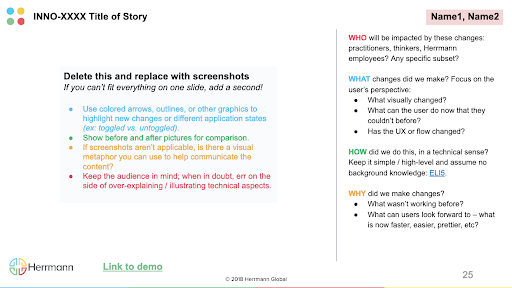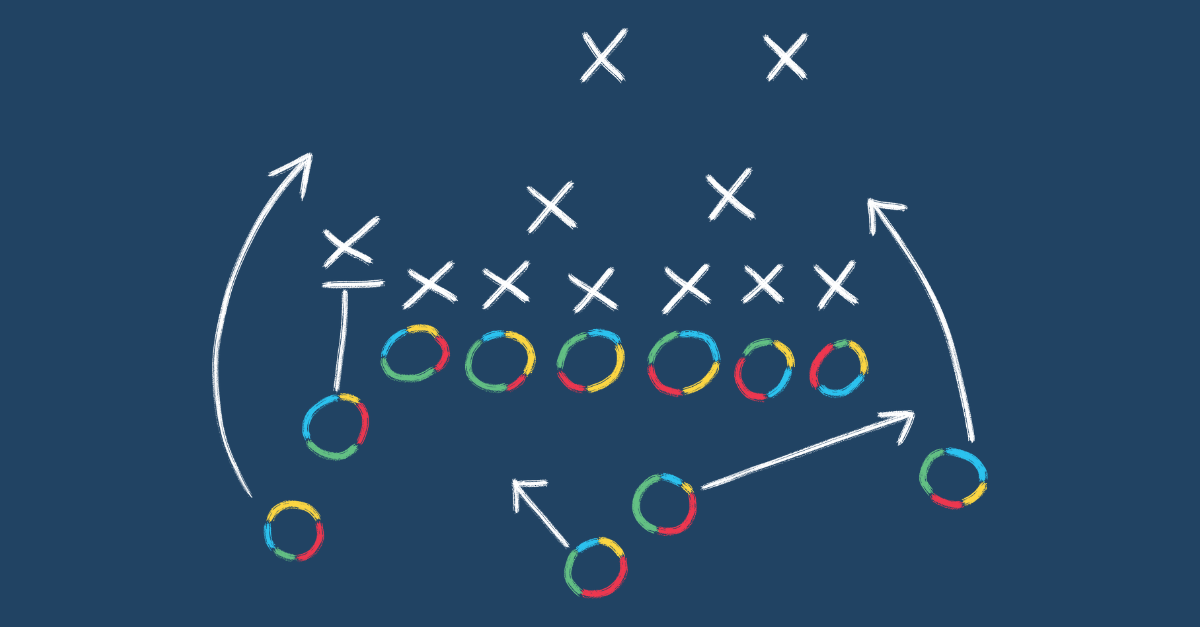One of the most important parts of the Scrum process is the Sprint Review. It’s the chance to show your work to a broad audience, get feedback, and get aligned on where to focus next. Whole Brain® Thinking can be applied here to ensure the outputs land with as many different Thinkers as possible.
Different teams do their reviews differently, and we’ve settled on a format that mixes a series of slides along with small demos. We find that in many cases, 1-2 slides to accompany a demo help set the context better and give us a chance to provide information about business consequences to the work that might not be immediately obvious. It also means we have a handy little take away that coworkers can use to review things after the meeting.
Each developer is responsible for preparing slides and demos for the particular stories they worked on. To help them do so, we’ve created a Whole Brain template that looks like this:

You can see this template includes the following Whole Brain® WalkAround:
A
WHAT changes did we make? Focus on the user’s perspective:
• What visually changed?
• What can the user do now that they couldn’t before?
• Has the UX or flow changed?
B
HOW did we do this, in a technical sense? Keep it simple / high-level and assume no background knowledge: ELI5 ("Explain Like I'm 5").
C
WHO will be impacted by these changes: practitioners, thinkers, Herrmann employees? Any specific subset?
D
WHY: did we make changes?
• What wasn't working before?
• What can users look forward to – what is now faster, easier, prettier, etc?
We deliberately chose to lead with the WHO in the template because that's our team's lowest preference. Putting it first forces us to prioritize it, ensuring we’re keeping our communications relevant.
Since starting to use the format, we’ve seen positive results and improved collaboration. Here are some thoughts about this format from our team:
I think having the C and D is great for ensuring that we set the right context. While it mirrors the user story format, it may be more clear for people who are not intimately familiar with user stories.
– Jonathan Berg, VP of Product
It is more self-organizing in terms of setting priorities for the issues to be addressed and the specifics of the action items. Instead of getting directives from management, this approach enables team members to make decisions from their hands-on experience with the issue from the sprint.
– Charles Kuo, QA Engineer
Lastly, one of the great things about working at Herrmann is how the model becomes a big part of everyone's workflow. This tool, in particular, was not developed by any of our expert practitioners – it was developed by one of our own engineers. Having Whole Brain® Thinking as a core part of our culture means that our team members are always finding new ways to apply our tools and improve our processes.
How do you think using the Whole Brain® Sprint Review might help your organization? We’d love to hear from you and answer any questions about how it’s made a difference for our team!
At Herrmann, one of our key fundamentals is that we try to "eat our own cooking" and use Whole Brain® Thinking in our own work. This post is part of a series where our engineering team talks about how they use Whole Brain® Thinking in their own workflow.
This post is by our Platform Team Lead, Andrew Swerlick.











